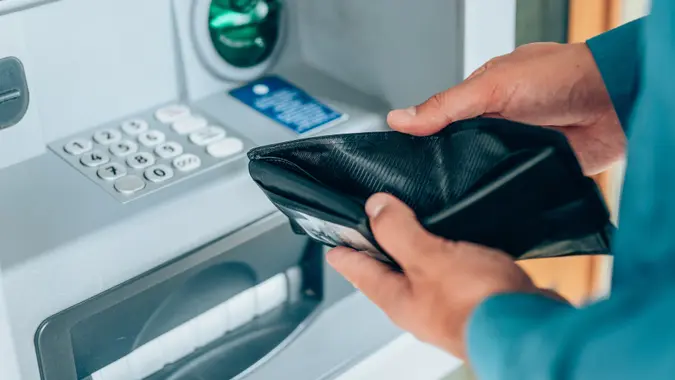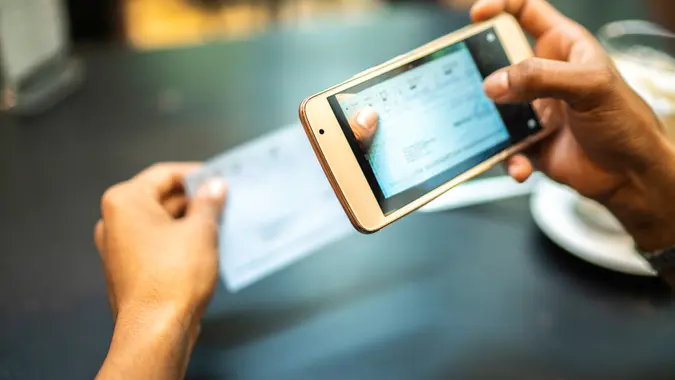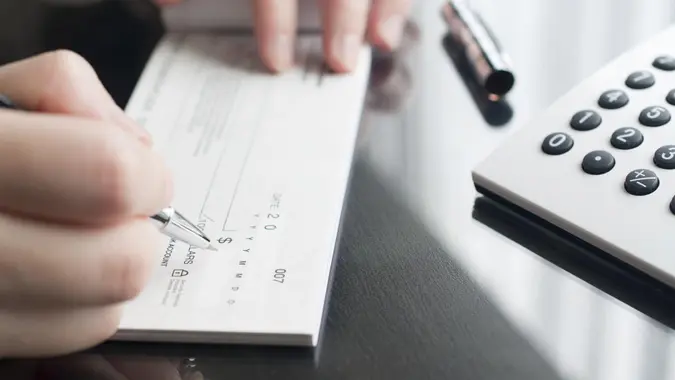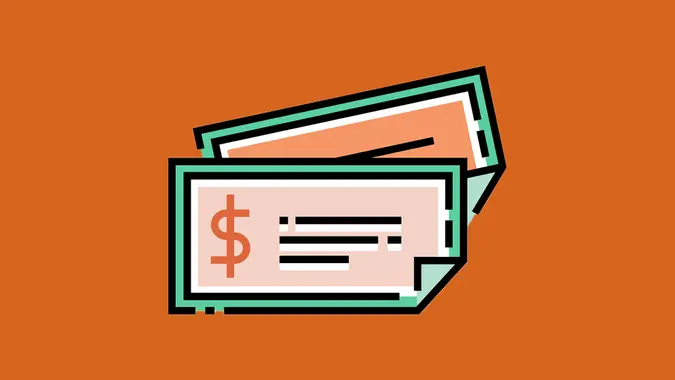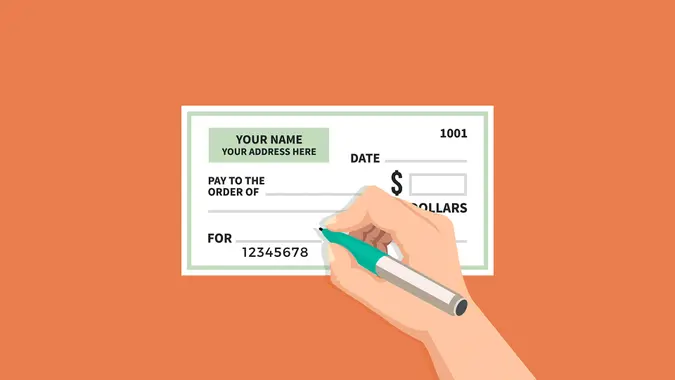What Is a Debit Card?

Commitment to Our Readers
GOBankingRates' editorial team is committed to bringing you unbiased reviews and information. We use data-driven methodologies to evaluate financial products and services - our reviews and ratings are not influenced by advertisers. You can read more about our editorial guidelines and our products and services review methodology.

20 Years
Helping You Live Richer

Reviewed
by Experts

Trusted by
Millions of Readers
A debit card is a payment card that lets you pay for purchases or withdraw money directly from your checking account in your bank, credit union or other financial institution. It is often also referred to as an ATM or bank card, and offers the convenience of cashless transactions without incurring debt you’d have to repay with interest.
Unlike credit cards, debit cards draw from money you already have. They also don’t have the fees and interest rates credit cards are.
Read: How To Guard Your Wealth From a Potential Banking Crisis With Gold
How Does a Debit Card Work?
Debit cards can be used for in-store or online purchases wherever the payment processing network indicated by the card’s logo, such as Mastercard or Visa debit card, is accepted.
You can also use a debit card to withdraw money from your bank account, whether via an ATM or by requesting cash back at the register when you pay with the card in a personal identification number, or PIN, transaction.
What Does the PIN Do?
When you open your checking account, you’ll be asked to pick a four-digit PIN. This stands for personal identification number.
When you make a purchase in stores or use an ATM, you’ll have to provide your PIN to use your debit card.
Signing the Back of Your Debit Card
Signing the back of a debit card is a holdover from older security methods. Cashiers used to compare the signatures on receipts to the one on the card. Now, it’s a way to signal that your card is active.
What Happens when you Swipe, Insert or Tap a Debit Card?
There are several different ways a card reader can process your debit card information.
Swipe
There’s a magnetic strip that you use when you swipe your card. This strip contains data about your account info. The reader will send this data to the bank that the store is using, make sure the account is valid, then process the transaction.
Insert
When you insert your debit card into a card reader, the reader is processing the metal square on your card known as an EMV chip. This chip also contains your account data.
This method is thought to be safer than swiping your card because skimming machines can’t read your card data through this method.
Tap
Tapping your card is the newest way to pay. If your card has four curved lines on the front, it means you can use the tap to pay option.
This card uses near-field communication to give your account details to the store’s bank.
Types of Debit Cards
There are several types of debit cards available.
Traditional Debit Cards
A traditional debit card is sent to you by your bank to use for purchases or ATMs.
Prepaid Debit Cards
Prepaid debit cards allow you to have a debit card without a bank account. You pay a fee to load a sum of money onto a prepaid card and use it just like a traditional debit card.
Digital Debit Cards
Digital debit cards are stored in digital wallets, usually on your mobile phone. This can allow you to use your debit card at stores or online without your pin number.
Advantages of Using a Debit Card
There are several advantages of using a debit card:
- It helps to manage your money. You can only spend what you have, so you won’t have the repercussions of high-interest rates and suffocating monthly balances.
- It can be a way to simplify your finances because you see all your purchases and withdrawals on a single bank statement.
- You don’t have to meet credit requirements.
- Provides the convenience of plastic but doesn’t rack up debt as credit cards can.
Disadvantages of Using a Debit Card
There are also several drawbacks:
- It’s not reported to the credit bureaus, so it doesn’t help you establish or strengthen your credit.
- There are daily spending and withdrawal limits that can cause your card to be declined if you try to make a large purchase or ATM withdrawal.
- Rewards programs are usually not as robust as those offered by credit cards.
- Some merchants, such as gas stations, place a temporary hold on funds in your account to ensure you have enough money to pay for the purchase. These holds are usually released within 48 hours.
How to Get a Debit Card
The good news is that getting a debit card is easy. When you open a checking account at a financial institution, you usually will receive a free debit card as part of the process. If not, you can request one.
When you’re considering opening a checking account and getting a debit card, look for a bank that offers a free checking account or makes it easy to avoid fees. Compare each bank’s monthly fees for opening and using a checking account. Some banks have daily account balance minimums to avoid fees, while others do not. Careful planning can help you save money.
Debit Card Fees: What to Watch Out For
Accounts that come with debit cards don’t usually accrue monthly interest charges. Plus, your bank might charge other debit card fees, such as:
- ATM fees
- Out-of-network ATM charges
- Monthly maintenance fees
- Overdraft fees
- Foreign transaction fee
Debit Card Security: How to Protect Yourself
The general fear about debit cards is the risk of becoming a victim of fraud because the card is directly attached to your bank account. But banks have anti-fraud measures in place to keep your card and your account secure.
According to the FTC, if you report your card as lost or stolen, any transactions that happen after that aren’t your responsibility.
Here are some tips to keep your debit card secure:
- Use the chip or tap to pay option on your debit card to protect your information from skimmers
- If you lose your debit card, let your bank know right away. Some banks offer options to turn off your debit card from the mobile app. This can help prevent someone from using your card.
- Monitor your checking account statements. This can help you catch transactions you didn’t make so you can report them immediately.
- Avoid ATMs not owned by your bank. This can protect you from tampered ATMs that have card skimmers.
- Don’t let other people use your debit card.
- Don’t share your PIN.
Using Debit Cards for Online Shopping
Although it is generally safe to use your debit card for online shopping, many people consider credit cards to be more secure. This is because if your account information is stolen from your credit card, the thief doesn’t have access to your bank account.
What to Do If Your Debit Card Is Declined
There are several reasons why your debit card is being declined:
- You input the wrong information
- If you’re using the magnetic strip, the strip is damaged
- You don’t have enough money in the account
- The card reader made an error
If your card is damaged, contact your bank for a new one. If your bank account is low, sign up for notifications about your account balance. This can help you keep track of when pending transactions go through.
Comparing Debit Cards to Other Payment Methods
Debit cards are a secure way to make payments. However, you can also use:
Is a Debit Card Right For You?
A debit card is a great payment tool to have at the beginning of your financial journey. However, if you’re looking to build your credit or benefit from rewards programs, you’ll need a credit card.
Keep your debit card secured and stay aware of your account balance.
Daria Uhlig contributed to the reporting for this article.
Our in-house research team and on-site financial experts work together to create content that’s accurate, impartial, and up to date. We fact-check every single statistic, quote and fact using trusted primary resources to make sure the information we provide is correct. You can learn more about GOBankingRates’ processes and standards in our editorial policy.
- Washington State Department of Financial Institutions. "Debit Cards Frequently Asked Questions."
- FTC. "Lost or Stolen Credit, ATM, and Debit Cards"
 Written by
Written by  Edited by
Edited by 









